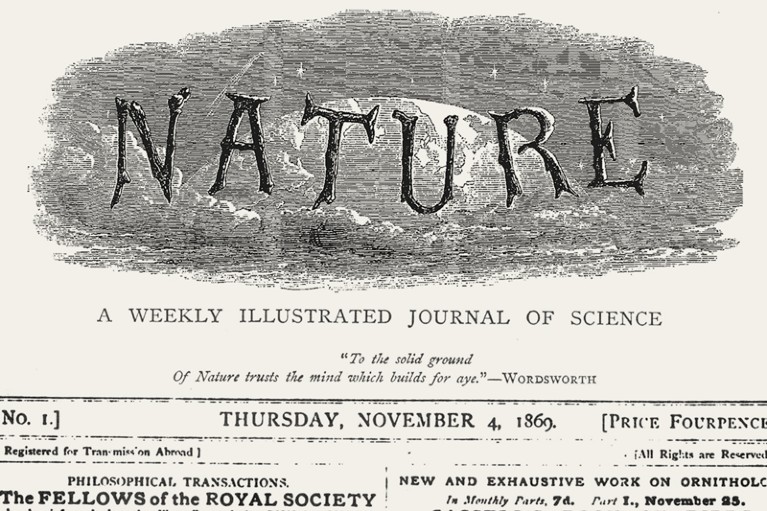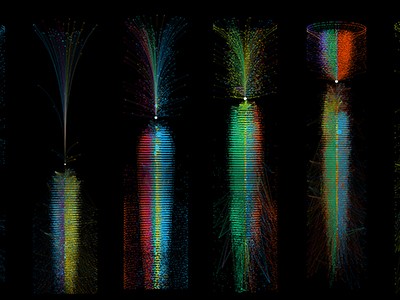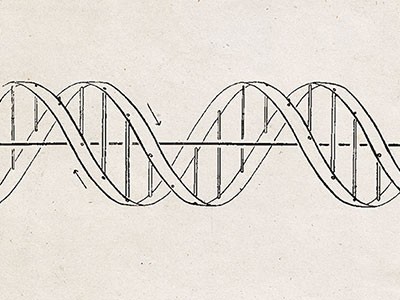
Nature made its debut on 4 November 1869.
On 4 November 1869, the first issue of Nature made its way into the world. Its ambition was intellectually bold and commercially risky: to bring news of the latest discoveries and inventions to scientists and the public alike.
Although the journal was aimed at a broad audience, scientists took a particular liking to it — because it allowed them to communicate their findings quickly. Nature’s weekly schedule offered a refreshing contrast to the leisurely timescales of learned-society journal publishing and conference proceedings. And, as universities grew, more ‘letters to the editor’ from scientists started arriving at the Nature offices in London. The journal became a venue for publishing discoveries because its writers also became its readers — and we have been trying to serve scientists and society ever since.
Celebrating 150 years of Nature
In this, Nature’s 150th anniversary issue, we’re celebrating and remembering many of the notable discoveries that authors have communicated in the journal’s pages, along with the agenda-setting journalism and commentary that has always been an essential part of our voice.
A century and a half is long enough to see how our understanding of the natural world changes with each instalment of new evidence. Take human origins. In February 1925, Nature published the discovery by Raymond Dart of Australopithecus africanus in South Africa1. It was the first fossil link between humans and apes, and it caused a sensation, providing evidence that humans evolved from a common ancestor in Africa as Charles Darwin had proposed — and not in Britain or Indonesia as had previously been thought.
Nearly 80 years later, the discovery of the remains of Homo floresiensis in 2004, which came to be known as the hobbit, demonstrated that our genus was remarkably diverse2. Further revelations about human prehistory and evolution quickly followed, culminating in advances in ancient genomics. These have revealed that, as recently as 30,000 to 60,000 years ago, humans coexisted and had offspring with other hominins — Neanderthals and Denisovans3.
Explore Nature’s archive in an interactive graphic
Nature also published some of the remarkable developments that took place in physics in the early part of the twentieth century. These include James Chadwick’s proposal in 1932 of the existence of a new particle, the neutron, to add to the electron and the proton4. Today, many more fundamental particles have been discovered because of the predictions of the standard model of particle physics. Some of the earliest findings of exoplanets appeared in our pages, including, in 1995, the first report of an exoplanet orbiting around a Sun-like star in another galaxy5 — for which Michel Mayor and Didier Queloz won a share of the 2019 Nobel Prize in Physics.
Arguably, Nature’s most memorable publications were the reports in April 1953 on the structure of DNA — including papers from Maurice Wilkins6 and Rosalind Franklin7, in addition to the paper by Francis Crick and James Watson8. The discovery that DNA was a double helix changed biology forever. Forty years later, we proudly published the first draft sequence of a human genome carried out by a publicly funded group, the International Human Genome Sequencing Consortium9. Without the researchers’ collective achievement, medicine, agriculture, conservation and criminal justice would look very different today.
10 extraordinary Nature papers
There is, of course, no definitive list of the most influential or important pieces of research that Nature has published. A series of News & Views articles explains the importance and lasting impact of ten key papers from our archive. We also chose a long list of 150 interesting, illuminating, entertaining and sometimes controversial articles — one for every year of our life — and have been posting one per day on social media for the past few months. But even compiling this longer list involved vigorous and sometimes tense discussion among the editors.
At the start of the year, we also began discussing what to feature on our anniversary issue cover. The result — a data analysis of Nature’s archive which highlights the multidisciplinary scope of the journal — is rendered as the extraordinary fireworks you can see on the cover and in a video and interactive visualization. Our anniversary issue includes a rich variety of written and multimedia content on the past, present and future of Nature and of research itself.
Responsible science
As science has advanced during the past century and a half, discovery has gone hand in hand with world-changing inventions — particularly in industrial-scale technologies. Many of these technologies, from the internal combustion engine to synthetic agrochemicals, have improved the quality of life for hundreds of millions of people; but at the same time they have also damaged the environment or raised serious ethical and safety concerns.
In some cases, researchers have been able to sound the alarm in time for remedial action, as chemists Mario Molina and Sherwood Rowland did in June 1974 when they worked out that chlorine originating from chlorofluorocarbons (CFCs) was destroying atmospheric ozone10. A decade later, physicist Joe Farman and colleagues showed that ozone levels over Antarctica were lower than expected — the first detection of the ozone hole11.
These findings led to the 1989 Montreal Protocol, an international agreement to cut ozone-depleting substances, and a shining example of how people can unite to take action when scientific evidence points to an impending environmental disaster. Sadly, the same cannot yet be said for climate change, even though researchers have been sounding ever-louder warnings since the 1970s that greenhouse-gas emissions are warming the planet.
As the pace of discovery and invention accelerates — from isolating stem cells12 to the development of cloning13 and gene-editing technologies, to last month’s description of quantum supremacy14 — there is a clear need, perhaps now more than ever, for researchers and research publishers to acknowledge, and implement, our responsibility to society. We must commit to greater openness and ensure that findings are reproducible, and we must act with integrity at all times. Nature and the researchers it serves have a duty to work side by side with those in our broader society who will be affected by the products of research, and to consider generations to come.
Room to improve
Looking back, there have been times when Nature did not adhere to standards that we hold ourselves to today. We should have called out when Jocelyn Bell Burnell was overlooked for the Nobel physics prize for her work in the discovery of pulsars15. And it shouldn’t have taken until 2007 for us to replace the phrase “scientific men” with “scientists” in our mission statement.
Organized peer review — the cornerstone of scientific publishing — was introduced in Nature only after 1966, although we have tried to make up for lost time since. In 2006, Nature conducted trials on open peer review; we now offer authors double-blind peer review, and are one of several journals in the Nature family to offer reviewers the opportunity to be named.
Another area where overdue change is under way is in the people represented in the journal. In the early years, Nature was dominated by papers with one or two authors, mostly male, and mostly from the Northern Hemisphere. Today, papers with a single author are almost unheard of and author lists can run to the thousands, reflecting the increasingly team-based nature of current research. Although most of our authors still come from institutions in Europe and North America — where most research funding is concentrated — our author community is becoming more geographically diverse.
But researchers from large parts of the world, notably Africa, remain under-represented. This reflects broader inequalities that stem from the uncomfortable historical reality that science and empire often worked in a symbiotic relationship. We recognize that Nature was founded at the height of such an age. Change will need time, but we are committed to doing more to make a difference.
View to the future
As the boundaries between disciplines blur and research becomes increasingly multi- and transdisciplinary, Nature is moving beyond a traditional focus on the natural sciences to embrace social sciences, translational and clinical research and applied science and engineering. Looking to the future, we hope to contribute to greater transparency and openness in academia. We will probably see even more collaborative ways of doing research and more changes in the way it is published.
Predicting the future is notoriously difficult. Writer William Gibson, in his 1984 cyberpunk novel Neuromancer, foresaw a form of today’s stem-cell therapy and sophisticated artificial intelligence, but failed to anticipate mobile phones. Even in the early 1990s, relatively few people anticipated that ‘electronic publishing’, as it was starting to be called, would jeopardize the future of mass-produced printed journals. The most exciting and dramatic changes will be the ones we cannot imagine today.
It’s unlikely that our founders imagined that, 150 years on, Nature would be publishing more than 850 research papers and 3,000 articles of news, opinion and analysis each year, and reaching around 4 million readers online each month. That’s your doing: researchers and their remarkable discoveries have made us what we are. We have reached this important milestone only through listening, responding and adapting to the community we serve.
In other respects, Nature now is just the same as it was at the start. We will continue in our mission to stand up for research, serve the global research community and communicate the results of science around the world. We will strive to hold to account those in positions of responsibility in research, policy and industry, and to continue to advocate for fewer unintended harmful consequences of research for people and the planet.
Research, science, knowledge, scholarship — however we might choose to characterize the marshalling of evidence in the pursuit of truth — the values we hold are more important than ever before.

 Celebrating 150 years of Nature
Celebrating 150 years of Nature
 Explore Nature’s archive in an interactive graphic
Explore Nature’s archive in an interactive graphic
 150 years of Nature: a data graphic charts our evolution
150 years of Nature: a data graphic charts our evolution
 Science must move with the times
Science must move with the times
 Nature’s reach: narrow work has broad impact
Nature’s reach: narrow work has broad impact
 10 extraordinary Nature papers
10 extraordinary Nature papers
 150 years of scientific illustration
150 years of scientific illustration





